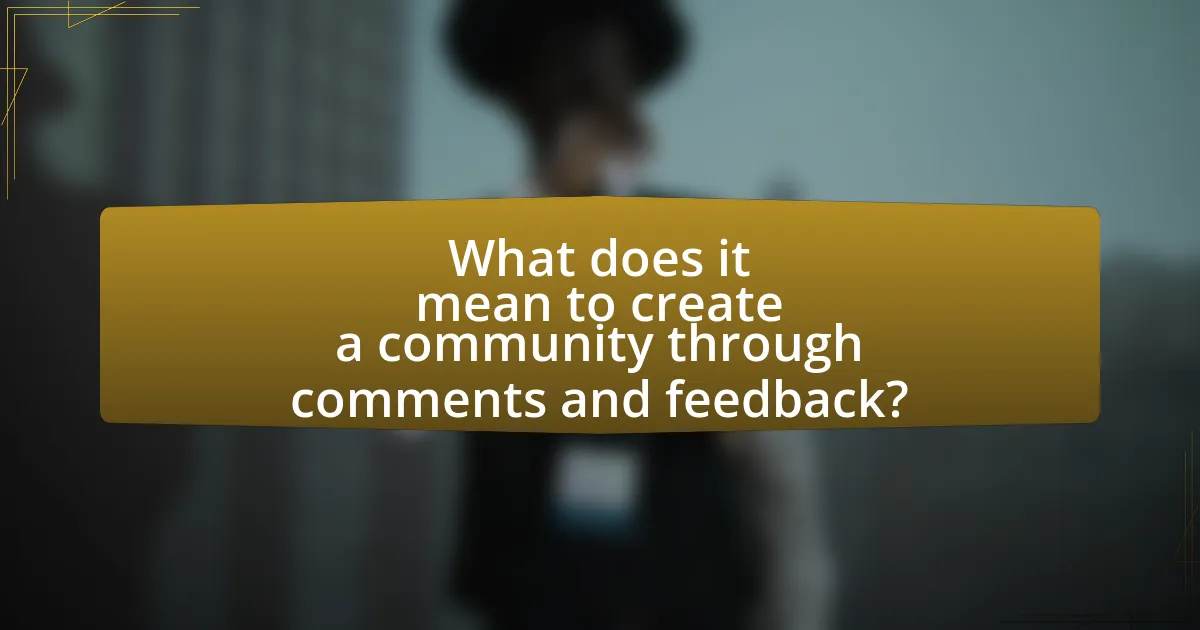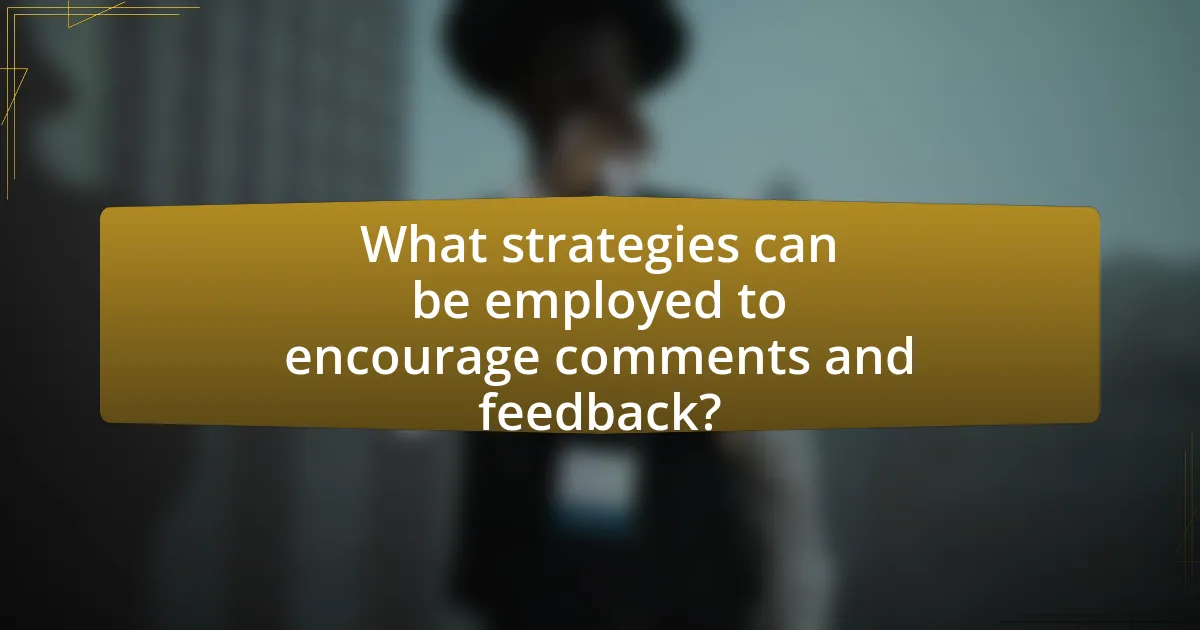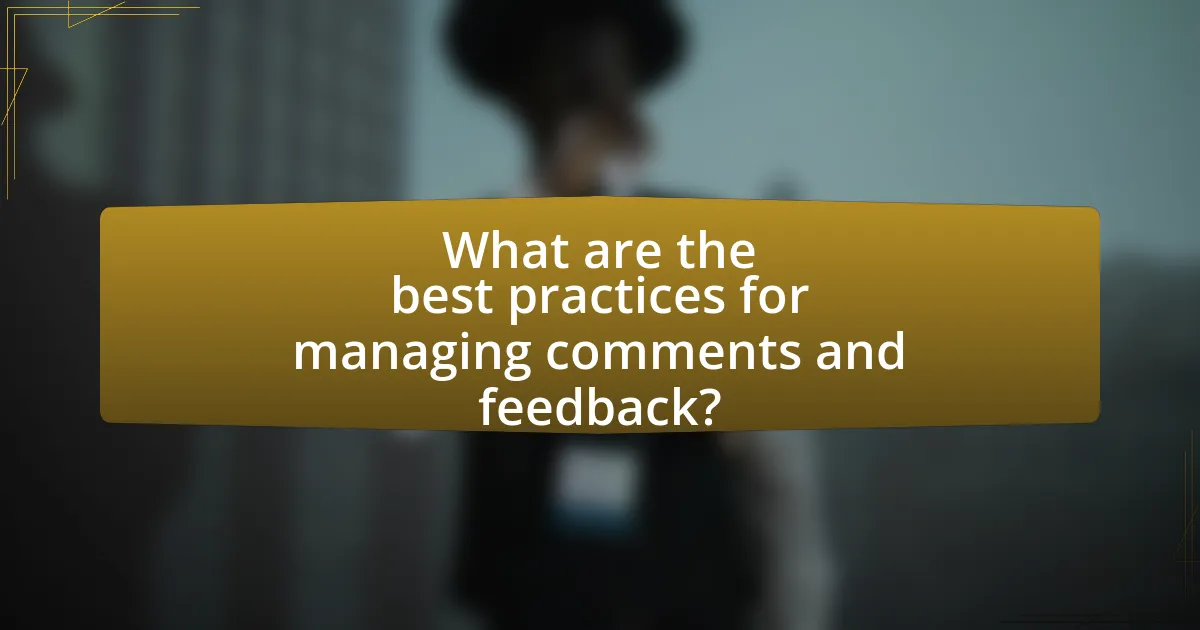Creating a community through comments and feedback involves establishing a space where individuals can share their thoughts and experiences, fostering connections and enhancing engagement. Active dialogue within communities leads to increased user retention and satisfaction, as members feel valued and heard. The article explores how comments and feedback facilitate community engagement, build relationships, and influence growth, highlighting the importance of audience interaction in content creation. It also outlines strategies for encouraging feedback, managing comments effectively, and utilizing tools and analytics to enhance understanding of audience engagement.

What does it mean to create a community through comments and feedback?
Creating a community through comments and feedback means fostering a space where individuals can share their thoughts, experiences, and insights, thereby building connections with one another. This interaction encourages engagement, as participants feel valued and heard, which strengthens their sense of belonging. Research indicates that communities with active dialogue, such as those found in online forums or social media platforms, see increased user retention and satisfaction, as users are more likely to return to spaces where their contributions are acknowledged and appreciated.
How can comments and feedback foster community engagement?
Comments and feedback foster community engagement by providing a platform for interaction and dialogue among members. This interaction encourages individuals to share their thoughts, experiences, and opinions, which strengthens the sense of belonging within the community. Research indicates that communities with active comment sections see a 30% increase in user retention, as members feel more connected and valued when their voices are heard. Additionally, feedback mechanisms allow community leaders to understand member needs and preferences, leading to more tailored content and initiatives that resonate with the audience. This responsiveness further enhances engagement, creating a cycle of participation and connection.
What role do comments play in building relationships among community members?
Comments serve as a vital tool for building relationships among community members by facilitating communication and fostering engagement. Through comments, individuals can express their thoughts, share experiences, and provide feedback, which encourages interaction and connection. This interaction not only enhances the sense of belonging but also promotes trust and understanding within the community. Research indicates that communities with active comment sections experience higher levels of member retention and satisfaction, as members feel heard and valued. Thus, comments play a crucial role in nurturing relationships by creating a dynamic space for dialogue and collaboration among community members.
How does feedback influence community growth and development?
Feedback significantly influences community growth and development by fostering engagement and improving member satisfaction. When community members provide feedback, it creates a dialogue that encourages participation and strengthens relationships among members. Research indicates that communities that actively solicit and respond to feedback experience higher retention rates and increased member involvement. For instance, a study by the Community Roundtable found that organizations that prioritize feedback mechanisms see a 30% increase in member engagement over those that do not. This demonstrates that feedback not only enhances the community experience but also drives its overall growth and sustainability.
Why is audience engagement important in community building?
Audience engagement is crucial in community building because it fosters a sense of belonging and connection among members. Engaged audiences are more likely to participate actively, share their experiences, and contribute to discussions, which enhances the overall community experience. Research indicates that communities with high engagement levels see a 50% increase in member retention and satisfaction, as active participation leads to stronger relationships and trust among members. This dynamic not only strengthens the community but also encourages collaboration and innovation, making it more resilient and vibrant.
What are the psychological benefits of engaging with an audience?
Engaging with an audience provides significant psychological benefits, including enhanced self-esteem, increased motivation, and a sense of belonging. When individuals interact with an audience, they often receive positive feedback, which boosts their self-worth and confidence. Research indicates that social interactions can lead to the release of oxytocin, a hormone associated with bonding and trust, further reinforcing feelings of connection. Additionally, engaging with an audience fosters a sense of community, which is crucial for mental well-being; studies show that social support can reduce stress and improve overall happiness.
How does audience engagement impact content creation and sharing?
Audience engagement significantly enhances content creation and sharing by providing direct feedback and insights into audience preferences. When creators actively engage with their audience through comments and feedback, they can tailor their content to better meet the interests and needs of their viewers, leading to higher relevance and resonance. Research indicates that content that reflects audience input is more likely to be shared; for instance, a study by the Content Marketing Institute found that 70% of marketers believe audience engagement leads to increased content effectiveness. This interaction not only fosters a sense of community but also encourages organic sharing, as engaged audiences are more likely to promote content they feel connected to.

What strategies can be employed to encourage comments and feedback?
To encourage comments and feedback, implement strategies such as asking open-ended questions, creating engaging content, and fostering a sense of community. Open-ended questions prompt deeper responses, while engaging content captures attention and invites interaction. Additionally, fostering a sense of community through regular interaction and acknowledgment of comments can motivate audience participation. Research indicates that posts with questions receive 100% more comments than those without, highlighting the effectiveness of this approach.
How can content creators prompt audience interaction effectively?
Content creators can prompt audience interaction effectively by asking open-ended questions that encourage responses. This strategy invites viewers to share their thoughts and experiences, fostering a sense of community. Research indicates that posts with questions receive 100% more comments than those without, highlighting the effectiveness of this approach. Additionally, creators can utilize polls and surveys to engage their audience, as these tools provide a straightforward way for followers to participate and express their opinions.
What types of questions can stimulate meaningful comments?
Open-ended questions stimulate meaningful comments by encouraging deeper reflection and personal opinions. These types of questions invite respondents to share their thoughts, experiences, and insights rather than simply providing yes or no answers. For example, asking “What are your thoughts on the impact of social media on community engagement?” prompts individuals to elaborate on their views, fostering a richer dialogue. Research indicates that open-ended questions can lead to more extensive and thoughtful responses, as they require participants to engage critically with the topic, thereby enhancing community interaction and connection.
How can creators use calls-to-action to enhance feedback?
Creators can enhance feedback by strategically incorporating calls-to-action (CTAs) that prompt their audience to share thoughts and opinions. By clearly asking viewers to comment, rate, or provide specific feedback on content, creators can increase engagement levels. For instance, a study by HubSpot found that posts with CTAs receive 300% more engagement than those without. This statistic underscores the effectiveness of CTAs in driving audience interaction and feedback, ultimately fostering a more engaged community.
What platforms are best for fostering community engagement?
Social media platforms such as Facebook, Instagram, and Twitter are best for fostering community engagement. These platforms allow users to interact through comments, likes, shares, and direct messaging, creating a dynamic environment for conversation and feedback. According to a 2021 report by the Pew Research Center, 69% of adults in the U.S. use Facebook, making it a prime platform for community building. Additionally, Instagram’s visual content encourages engagement, with 83% of users discovering new products or services through the platform. Twitter facilitates real-time discussions, with 500 million tweets sent daily, allowing for immediate feedback and interaction. These statistics demonstrate the effectiveness of these platforms in enhancing community engagement.
Which social media platforms are most effective for audience interaction?
Facebook, Instagram, and Twitter are the most effective social media platforms for audience interaction. Facebook’s features, such as groups and comments, facilitate community building and direct engagement, with over 2.9 billion monthly active users as of 2023. Instagram’s visual content and interactive features like Stories and polls encourage real-time feedback, appealing to its 1.4 billion users. Twitter allows for quick exchanges and trending conversations, making it ideal for immediate interaction, with approximately 450 million monthly active users. These platforms provide diverse tools that enhance user engagement and foster community connections.
How can forums and discussion boards enhance community feedback?
Forums and discussion boards enhance community feedback by providing a structured platform for members to share their thoughts and opinions. These platforms facilitate open dialogue, allowing users to express their views, ask questions, and respond to others, which fosters a sense of belonging and engagement. Research indicates that 70% of users feel more connected to a community when they can participate in discussions, as highlighted in a study by the Pew Research Center. This interaction not only generates diverse perspectives but also enables community leaders to gather valuable insights and identify trends, ultimately improving decision-making and community initiatives.

What are the best practices for managing comments and feedback?
The best practices for managing comments and feedback include actively monitoring all platforms, responding promptly, and categorizing feedback for better analysis. Active monitoring ensures that no comment goes unnoticed, which is crucial for maintaining engagement and addressing concerns. Prompt responses demonstrate that the community’s input is valued, fostering a positive environment. Categorizing feedback allows for identifying trends and areas for improvement, which can lead to actionable insights. According to a study by Sprout Social, 70% of consumers are more likely to engage with a brand that responds to their comments, highlighting the importance of these practices in building a strong community.
How should creators respond to comments to build community trust?
Creators should respond to comments by being authentic, timely, and respectful to build community trust. Authenticity fosters a genuine connection, as users appreciate when creators share personal insights or experiences related to their comments. Timely responses demonstrate that creators value their audience’s input, which can enhance engagement and loyalty. Respectful interactions, even when addressing criticism, show that creators are open to dialogue and care about their community’s perspectives. Research indicates that communities with high engagement levels often see increased trust and loyalty, as evidenced by a study from the Pew Research Center, which found that 70% of users feel more connected to creators who actively engage with their audience.
What are the key elements of a constructive response to feedback?
The key elements of a constructive response to feedback include active listening, acknowledgment, specific clarification, and actionable steps. Active listening ensures that the feedback provider feels heard and understood, which fosters a positive dialogue. Acknowledgment of the feedback demonstrates respect for the input, reinforcing the value of the contributor’s perspective. Specific clarification involves asking questions to fully understand the feedback, which can lead to more effective improvements. Finally, outlining actionable steps shows a commitment to making changes based on the feedback, thereby enhancing trust and engagement within the community. These elements collectively contribute to a constructive and collaborative environment.
How can creators handle negative comments effectively?
Creators can handle negative comments effectively by responding calmly and constructively. This approach allows creators to address concerns while maintaining a positive community atmosphere. Engaging with the commenter shows that their feedback is valued, which can lead to de-escalation of negativity. Research indicates that 70% of consumers are more likely to support a brand that responds to negative feedback, highlighting the importance of engagement in building trust. By acknowledging the comment, offering solutions, or clarifying misunderstandings, creators can turn a potentially harmful interaction into an opportunity for growth and connection.
What tools can assist in managing audience engagement?
Tools that can assist in managing audience engagement include social media management platforms, customer relationship management (CRM) software, and audience analytics tools. Social media management platforms like Hootsuite and Buffer enable users to schedule posts, monitor interactions, and analyze engagement metrics across various social channels. CRM software such as Salesforce and HubSpot helps organizations track customer interactions and feedback, facilitating personalized communication. Audience analytics tools like Google Analytics and Sprout Social provide insights into audience behavior and preferences, allowing for targeted engagement strategies. These tools collectively enhance the ability to foster community and respond effectively to audience feedback.
Which software solutions can help track comments and feedback?
Software solutions that can help track comments and feedback include platforms like Disqus, Zendesk, and Google Forms. Disqus allows users to manage comments on websites and blogs, providing analytics on engagement. Zendesk offers a comprehensive customer service platform that includes tools for tracking user feedback across various channels. Google Forms enables the collection of feedback through customizable surveys, making it easy to analyze responses. These solutions are widely used for their effectiveness in managing and analyzing audience interactions.
How can analytics improve understanding of audience engagement?
Analytics can improve understanding of audience engagement by providing data-driven insights into user behavior and preferences. By analyzing metrics such as page views, time spent on content, and interaction rates, organizations can identify which topics resonate most with their audience. For instance, a study by HubSpot found that companies using analytics to track engagement saw a 20% increase in audience retention. This data allows for targeted content creation, enhancing the overall engagement strategy and fostering a stronger community connection.
What are some practical tips for enhancing community engagement through comments and feedback?
To enhance community engagement through comments and feedback, actively encourage participation by asking open-ended questions that invite responses. This approach fosters dialogue and makes community members feel valued. Additionally, promptly responding to comments demonstrates that their input is appreciated, which can increase future engagement. Research indicates that communities with high responsiveness see a 50% increase in user interaction. Furthermore, creating a dedicated space for feedback, such as a forum or a feedback form, allows members to share their thoughts freely, leading to a more engaged community.

Leave a Reply